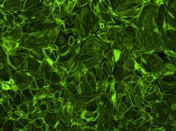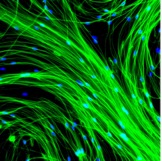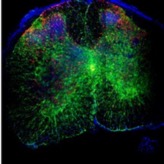Eleni Kanavas is the Acting Communications Specialist at CCRM. She has more than eight years of corporate communications experience working in the academic and health science fields. She graduated with an Honours BA in Journalism from the University of Toronto and an Ontario College Advanced Diploma in Journalism from Centennial College. Eleni previously worked at Sunnybrook Research Institute and the University of Toronto Scarborough Campus.
Science and tech-based art, or “sciart” for short, has changed the scientific landscape and motivated creative expression in different art forms. Some of the most colourful and vibrant science images are created in research labs behind the lens of a microscope.
Where science and art meet, so does science communication— the practice of informing, educating and raising awareness about science-related topics. Scientists are striving to explain scientific concepts and engage audiences to explore innovative ideas, and may use a variety of visual mediums and social media channels.
Over the past decade, there has been a growing number of scientific artwork exhibits and online contests organized by various academic and research institutions, and biotechnology companies, showcasing the beauty of science and technology. Some competitions even offer a cash prize.
Regular Signals’ readers, and followers of CCRM and the Stem Cell Network, will be familiar with the popular and long-standing Cells I See contest. (More on this below.) Now, other Canadian groups are getting in on the fun.
For the second year, STEMCELL Technologies has held their #StemCellfie contest to discover the best stem cell image. The top 20 images in the 2019 competition are posted on the company’s Facebook page.
 Mary Heather Florido, from the Beth Israel Deaconess Medical Center at Harvard, was crowned the grand prize winner for having the image (left) with the most “likes” and received a $500 travel award. The photo shows human vascular smooth muscle cells differentiated from induced pluripotent stem cells using the Cowan Lab protocol. The green staining is Phalloidin.
Mary Heather Florido, from the Beth Israel Deaconess Medical Center at Harvard, was crowned the grand prize winner for having the image (left) with the most “likes” and received a $500 travel award. The photo shows human vascular smooth muscle cells differentiated from induced pluripotent stem cells using the Cowan Lab protocol. The green staining is Phalloidin.
The Ontario Institute for Regenerative Medicine (OIRM) also hosted a contest earlier this year in search of sciart from Ontario scientists to decorate the bare walls of their new office in the MaRS building in downtown Toronto. Two winners were selected and each winner received a $500 travel award to attend an OIRM-approved conference or workshop related to stem cell or regenerative medicine.
 Ahmad Galuta, a PhD candidate from the University of Ottawa, won first-place for capturing how neural networks generated from spinal cord stem cells can form new connections after spinal cord injury (mage left).
Ahmad Galuta, a PhD candidate from the University of Ottawa, won first-place for capturing how neural networks generated from spinal cord stem cells can form new connections after spinal cord injury (mage left).
 Nishanth Lakshman, a PhD candidate from the University of Toronto, won second-place for a cross-section of a mouse spinal cord (image right) showing the migration of endogenous neural stem cells.
Nishanth Lakshman, a PhD candidate from the University of Toronto, won second-place for a cross-section of a mouse spinal cord (image right) showing the migration of endogenous neural stem cells.
Now in its 11th year, Cells I See has received around 200 entries showcasing the wonder of stem cells and biomaterials seen directly through the microscope. The 2019 competition is open and accepting submissions until August 30. If you think you have an award-winning image, visit the website for contest rules and enter today for your chance to win one of two cash prizes sponsored by OIRM: The People’s Choice Award ($500) or the Grand Prize ($750). Check out the Cells I See gallery for some inspiration.
Laurentian University has an annual sciart show featuring the artistic efforts of its community as well as that of the Greater Sudbury area. Watch the video below.
Guest
Latest posts by Guest (see all)
- Regenerative immunotherapy: Hope for chronic autoimmune diseases - September 16, 2025
- Canada’s regenerative revolution: Why AI is the catalyst - September 4, 2025
- Summer by Design: A launchpad for future entrepreneurs and industry scientists - August 14, 2025






Comments